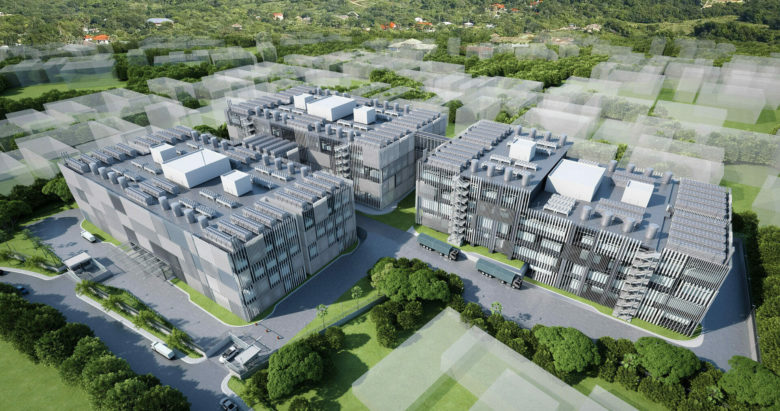
Rendering of SpaceDC’s planned data centre campus in Rizal, Philippines
Data centre provider SpaceDC is developing a 72 megawatt hyperscale campus in the eastern Greater Manila area as its first Philippine project, as the Singapore firm aims to build the country’s first green server hosting facility.
The data centre developer and operator says it is building a hyperscale data centre campus in Cainta, Rizal, east of Manila which will encompass three four-storey facilities spanning a total of 43,000 square metres (462,850 square feet) in combined floor area.
“The Philippines ranks second in terms of data center growth in Southeast Asia. With only 47MW of available capacity in the country it is a dramatically underserved market,” SpaceDC chief executive Darren Hawkins. “We are excited to be a first mover in a new market where we see our customers are investing heavily in.”
SpaceDC’s announcement of its entry in the Philippine digital infrastructure market came shortly after another Singapore player, Digital Edge, launched its Manila operations in December through a $100 million joint venture with a local real estate firm to build a 10 megawatt facility.
Green Data Centre
Known as Polymer Connected prior to its rebranding in late 2019 SpaceDC says it will source all of the power for its upcoming MNL1 facility from renewable sources such as wind and geothermal energy, while keeping the consumption efficient at a power usage effectiveness (PUE) of 1.3. That efficiency rating would put the Manila project in line with newly established guidelines in Singapore, which are among the most stringent globally and require all new data centres to achieve PUE of 1.3 or lower.

Darren Hawkins, chief executive officer of SpaceDC
The green data centre campus, which will also have its own four-storey admin building, is located 8.5 kilometres (5.3 miles) from the Makati central business district, with access to other commercial hubs in Metro Manila, including Bonifacio Global City in Taguig.
Slated to open this year, SpaceDC said the campus will offer direct connectivity to cloud providers including Alibaba, Amazon Web Services and Microsoft’s Azure. Real estate firm JLL has been appointed as project manager for the development.
Data halls in the buildings can accommodate up to 1,500 kilowatt of power capacity per 500 square metres of space. Other features of MNL1 include internet exchange and fiber connection, vendor neutral access, underground cable pathways and four “meet-me-rooms” which provide secure spaces for interconnection.
Prior to entering the Philippine market, SpaceDC has already established a pair of data centres in Indonesia named JAK1 and JAK 2, which together have around 26 megawatts of total power capacity, as well as a 48 megawatt facility in Noida, southeast of New Delhi in India, according to the company’s website.
Emerging Competition
“SpaceDC is in the right place at the right time to take advantage of the strong customer interest we are seeing in the Philippines,” said Ralph Davidson, JLL’s executive director and head of regional industries for Asia Pacific. “MNL1’s design is setting new standards in terms of technology, quality and operational excellence in the Philippines,” added Davidson.
SpaceDC’s project is going head to head with local telecommunications giant PLDT Inc which in October last year announced plans to developer the biggest hyperscale data centre in the country, according to local media reports. PLDT, which operates around 72 megawatts of total load across its 10 facilities in the country, has not yet disclosed the location and scale of the upcoming project.
In a separate press release on Wednesday, JLL is expecting more data centres will be built in the Greater Manila area by both local and foreign players as demand for internet service increases in the Philippines.
The country welcomed another foreign player in December when Digital Edge announced a partnership between Rufino clan’s Threadborne Group family office to build a data centre in Laguna province in the southeastern part of the Greater Manila area.
Note: An earlier version of this story indicated that SpaceDC is backed by GIC. The company is financially independent. Mingtiandi regrets the error.
Leave a Reply